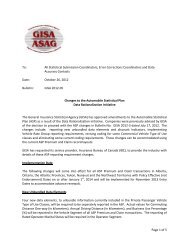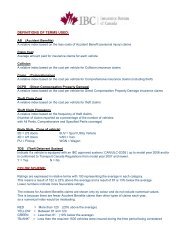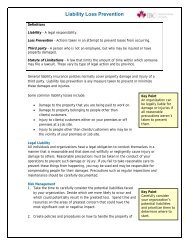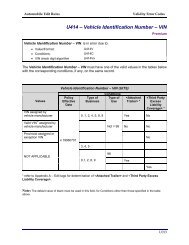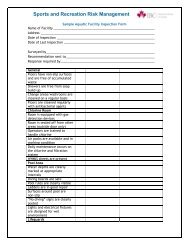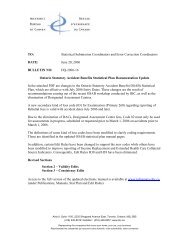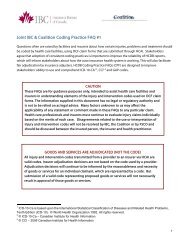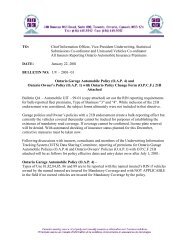Ontario Fault Determination Rules - Regulation 668 under the ...
Ontario Fault Determination Rules - Regulation 668 under the ...
Ontario Fault Determination Rules - Regulation 668 under the ...
You also want an ePaper? Increase the reach of your titles
YUMPU automatically turns print PDFs into web optimized ePapers that Google loves.
ONTARIO<strong>Regulation</strong> <strong>668</strong> <strong>under</strong> <strong>the</strong> Insurance Act(R.R.O. 1990, Reg. <strong>668</strong>)<strong>Fault</strong> <strong>Determination</strong> <strong>Rules</strong>© Queen’s Printer for <strong>Ontario</strong>, 1997. The copyright in <strong>the</strong> statutes and regulations of <strong>Ontario</strong> is owned by <strong>the</strong> Government of<strong>Ontario</strong>. This version is provided for purposes of convenience only. The authoritative text is set out in <strong>the</strong> official volumes.MENU OF REGULATIONSGeneral1. In this <strong>Regulation</strong>, “centre line” of a roadway means,(a) a single or double, unbroken or broken line marked in <strong>the</strong> middle of <strong>the</strong> roadway, or(b) if no line is marked, <strong>the</strong> middle of <strong>the</strong> roadway or that portion of <strong>the</strong> roadway that is not obstructedby parked vehicles, a snowbank or some o<strong>the</strong>r object blocking traffic.O. Reg. 276/90, s. 1.2. (1) An insurer shall determine <strong>the</strong> degree of fault of its insured for loss or damage arising directly orindirectly from <strong>the</strong> use or operation of an automobile in accordance with <strong>the</strong>se rules.(2) The diagrams in this <strong>Regulation</strong> are merely illustrative of <strong>the</strong> situations described in <strong>the</strong>se rules.O. Reg. 276/90, s. 2.3. The degree of fault of an insured is determined without reference to,(a) <strong>the</strong> circumstances in which <strong>the</strong> incident occurs, including wea<strong>the</strong>r conditions, road conditions,visibility or <strong>the</strong> actions of pedestrians; or(b) <strong>the</strong> location on <strong>the</strong> insured’s automobile of <strong>the</strong> point of contact with any o<strong>the</strong>r automobile involvedin <strong>the</strong> incident.O. Reg. 276/90, s. 3.4. (1) If more than one rule applies with respect to <strong>the</strong> insured, <strong>the</strong> rule that attributes <strong>the</strong> least degreeof fault to <strong>the</strong> insured shall be deemed to be <strong>the</strong> only rule that applies in <strong>the</strong> circumstances.(2) Despite subsection (1), if two rules apply with respect to an incident involving two automobiles andif <strong>under</strong> one rule <strong>the</strong> insured is 100 per cent at fault and <strong>under</strong> <strong>the</strong> o<strong>the</strong>r <strong>the</strong> insured is not at faultfor <strong>the</strong> incident, <strong>the</strong> insured shall be deemed to be 50 per cent at fault for <strong>the</strong> incident.O. Reg. 276/90, s. 4.5. (1) If an incident is not described in any of <strong>the</strong>se rules, <strong>the</strong> degree of fault of <strong>the</strong> insured shall bedetermined in accordance with <strong>the</strong> ordinary rules of law.(2) If <strong>the</strong>re is insufficient information concerning an incident to determine <strong>the</strong> degree of fault of <strong>the</strong>insured, it shall be determined in accordance with <strong>the</strong> ordinary rules of law unless o<strong>the</strong>rwiserequired by <strong>the</strong>se rules.O. Reg. 276/90, s. 5.
ABB<strong>Rules</strong> for Automobiles Travelling in <strong>the</strong> Same Direction and Lane6. (1) This section applies when automobile “A” is struck from <strong>the</strong> rear by automobile “B”, and bothautomobiles are travelling in <strong>the</strong> same direction and in <strong>the</strong> same lane.(2) If automobile “A” is stopped or is in forward motion, <strong>the</strong> driver of automobile “A” is not at faultand <strong>the</strong> driver of automobile “B” is 100 per cent at fault for <strong>the</strong> incident.BBAAAB(3) If automobile “A” is turning, ei<strong>the</strong>r to <strong>the</strong> right or to <strong>the</strong> left, in order to enter a side road,private road or driveway, <strong>the</strong> driver of automobile “A” is not at fault and <strong>the</strong> driver of automobile“B” is 100 per cent at fault for <strong>the</strong> incident.ONE WAYBAA
BAABB<strong>Rules</strong> for Automobiles Travelling in <strong>the</strong> Same Direction and Lane(4) If automobile “A” is in forward motion and is entering a parking place on ei<strong>the</strong>r <strong>the</strong> right or <strong>the</strong>left side of <strong>the</strong> road, <strong>the</strong> driver of automobile “A” is not at fault and <strong>the</strong> driver of automobile “B” is100 per cent at fault for <strong>the</strong> incident.ONE WAYPARKINGAAO. Reg. 276/90, s. 6.7. (1) This section applies when automobile “A” collides with automobile “B” while automobile “B” isentering a road from a parking place, private road or driveway.(2) If <strong>the</strong> incident occurs when automobile “B” is leaving a parking place and automobile “A” ispassing <strong>the</strong> parking place, <strong>the</strong> driver of automobile “A” is not at fault and <strong>the</strong> driver of automobile“B” is 100 per cent at fault for <strong>the</strong> incident.B
A<strong>Rules</strong> for Automobiles Travelling in <strong>the</strong> Same Direction and Lane(3) If <strong>the</strong> incident occurs when automobile “B” is entering a road from a private road or a drivewayand automobile “A” is passing <strong>the</strong> private road or driveway and, if <strong>the</strong>re are no traffic signals orsigns, <strong>the</strong> driver of automobile “A” is not at fault and <strong>the</strong> driver of automobile “B” is 100 per centat fault for <strong>the</strong> incident.BAO. Reg. 276/90, s. 7.8. If automobile “A” collides with automobile “B” on a controlled access road while automobile “B” isentering <strong>the</strong> road from an entrance lane, <strong>the</strong> driver of automobile “A” is not at fault and <strong>the</strong> driver ofautomobile “B” is 100 per cent at fault for <strong>the</strong> incident.BABO. Reg. 276/90, s. 8.
AAB<strong>Rules</strong> for Automobiles Travelling in <strong>the</strong> Same Direction and Lane9. (1) This section applies with respect to an incident involving three or more automobiles that aretravelling in <strong>the</strong> same direction and in <strong>the</strong> same lane (a “chain reaction”).(2) The degree of fault for each collision between two automobiles involved in <strong>the</strong> chain reaction isdetermined without reference to any related collisions involving ei<strong>the</strong>r of <strong>the</strong> automobiles andano<strong>the</strong>r automobile.(3) If all automobiles involved in <strong>the</strong> incident are in motion and automobile “A” is <strong>the</strong> leading vehicle,automobile “B” is second and automobile “C” is <strong>the</strong> third vehicle,(a) in <strong>the</strong> collision between automobiles “A” and “B”, <strong>the</strong> driver of automobile “A” is not at faultand <strong>the</strong> driver of automobile “B” is 50 per cent at fault for <strong>the</strong> incident;(b) in <strong>the</strong> collision between automobiles “B” and “C”, <strong>the</strong> driver of automobile “B” is not at faultand <strong>the</strong> driver of automobile “C” is 100 per cent at fault for <strong>the</strong> incident.C0% 50% 0% 100%(4) If only automobile “C” is in motion when <strong>the</strong> incident occurs,(a) in <strong>the</strong> collision between automobiles “A” and “B”, nei<strong>the</strong>r driver is at fault for <strong>the</strong> incident; and(b) in <strong>the</strong> collision between automobiles “B” and “C”, <strong>the</strong> driver of automobile “B” is not at faultand <strong>the</strong> driver of automobile “C” is 100 per cent at fault for <strong>the</strong> incident.BC0% 0% 0% 100%O. Reg. 276/90, s. 9.
BBAB<strong>Rules</strong> for Automobiles Travelling in <strong>the</strong> Same Direction in Adjacent Lane10. (1) This section applies when automobile “A” collides with automobile “B”, and both automobiles aretravelling in <strong>the</strong> same direction and in adjacent lanes.(2) If nei<strong>the</strong>r automobile “A” nor automobile “B” changes lanes, and both automobiles are on or over<strong>the</strong> centre line when <strong>the</strong> incident (a “sideswipe”) occurs, <strong>the</strong> driver of each automobile is 50 percent at fault for <strong>the</strong> incident.AA(3) If <strong>the</strong> location on <strong>the</strong> road of automobiles “A” and “B” when <strong>the</strong> incident (a “sideswipe”) occurscannot be determined, <strong>the</strong> driver of each automobile is 50 per cent at fault for <strong>the</strong> incident.CENTRAL ISLAND ORCENTRE OF THE ROAD
ABB<strong>Rules</strong> for Automobiles Travelling in <strong>the</strong> Same Direction in Adjacent Lane(4) If <strong>the</strong> incident occurs when automobile “B” is changing lanes, <strong>the</strong> driver of automobile “A” is notat fault and <strong>the</strong> driver of automobile “B” is 100 per cent at fault for <strong>the</strong> incident.BABACENTRAL ISLAND ORCENTRE OF THE ROAD(5) If <strong>the</strong> incident occurs when automobile “A” is turning left at an intersection and automobile “B” isovertaking automobile “A” to pass it, <strong>the</strong> driver of automobile “A” is 25 per cent at fault and <strong>the</strong>driver of automobile “B” is 75 per cent at fault for <strong>the</strong> incident.A
B<strong>Rules</strong> for Automobiles Travelling in <strong>the</strong> Same Direction in Adjacent Lane(6) If <strong>the</strong> incident occurs when automobile “A” is turning left at a private road or a driveway andautomobile “B” is overtaking automobile “A” to pass it, <strong>the</strong> driver of each automobile is 50 per centat fault for <strong>the</strong> incident.A(7) If <strong>the</strong> incident occurs when automobile “A” is turning left at a private road or a driveway andautomobile “B” is passing one or more automobiles stopped behind automobile “A”, <strong>the</strong> driverof automobile “A” is not at fault and <strong>the</strong> driver of automobile “B” is 100 per cent at fault for<strong>the</strong> incident.BABO. Reg. 276/90, s. 10.
<strong>Rules</strong> for Automobiles Travelling in <strong>the</strong> Same Direction in Adjacent Lane11. (1) This section applies with respect to an incident involving three or more automobiles that aretravelling in <strong>the</strong> same direction and in adjacent lanes (a “pile-up”).(2) For each collision between two automobiles involved in <strong>the</strong> pile-up, <strong>the</strong> driver of each automobileis 50 per cent at fault for <strong>the</strong> incident.O. Reg. 276/90, s. 11.
B<strong>Rules</strong> for Automobiles Travelling in Opposite Directions12. (1) This section applies when automobile “A” collides with automobile “B”, and <strong>the</strong> automobiles aretravelling in opposite directions and in adjacent lanes.(2) If nei<strong>the</strong>r automobile “A” nor automobile “B” changes lanes and both automobiles are on or over<strong>the</strong> centre lane when <strong>the</strong> incident (a “sideswipe”) occurs, <strong>the</strong> driver of each automobile is 50 percent at fault for <strong>the</strong> incident.AABB(3) If <strong>the</strong> location on <strong>the</strong> road of automobiles “A” and “B” when <strong>the</strong> incident (a “sideswipe”) occurscannot be determined, <strong>the</strong> driver of each automobile is 50 per cent at fault for <strong>the</strong> incident.A
BAA<strong>Rules</strong> for Automobiles Travelling in Opposite Directions(4) If automobile “B” is over <strong>the</strong> centre line of <strong>the</strong> road when <strong>the</strong> incident occurs, <strong>the</strong> driver of automobile“A” is not at fault and <strong>the</strong> driver of automobile “B” is 100 per cent at fault for <strong>the</strong> incident.B(5) If automobile “B” turns left into <strong>the</strong> path of automobile “A”, <strong>the</strong> driver of automobile “A” is not atfault and <strong>the</strong> driver of automobile “B” is 100 per cent at fault for <strong>the</strong> incident.AB
C<strong>Rules</strong> for Automobiles Travelling in Opposite Directions(6) If automobile “B” is leaving a parking place or is entering <strong>the</strong> road from a private road or driveway,and if automobile “A” is overtaking to pass ano<strong>the</strong>r automobile when <strong>the</strong> incident occurs, <strong>the</strong>driver of automobile “A” is not at fault and <strong>the</strong> driver of automobile “B” is 100 per cent at faultfor <strong>the</strong> incident.BAO. Reg. 276/90, s. 12.
<strong>Rules</strong> for Automobiles in an Intersection13. (1) This section applies with respect to an incident that occurs at an intersection that does not havetraffic signals or traffic signs.(2) If automobile “A” enters <strong>the</strong> intersection before automobile “B”, <strong>the</strong> driver of automobile “A” isnot at fault and <strong>the</strong> driver of automobile “B” is 100 per cent at fault for <strong>the</strong> incident.(3) If automobiles “A” and “B” enter <strong>the</strong> intersection at <strong>the</strong> same time and automobile “A” is to <strong>the</strong>right of automobile “B” when in <strong>the</strong> intersection, <strong>the</strong> driver of automobile “A” is not at fault and<strong>the</strong> driver of automobile “B” is 100 per cent at fault for <strong>the</strong> incident.(4) If it cannot be established whe<strong>the</strong>r automobile “A” or “B” entered <strong>the</strong> intersection first, <strong>the</strong> driverof each automobile shall be deemed to be 50 per cent at fault for <strong>the</strong> incident.O. Reg. 276/90, s. 13.14. (1) This section applies with respect to an incident that occurs at an intersection with traffic signs.(2) If <strong>the</strong> incident occurs when <strong>the</strong> driver of automobile “B” fails to obey a stop sign, yield sign or asimilar sign or flares or o<strong>the</strong>r signals on <strong>the</strong> ground, <strong>the</strong> driver of automobile “A” is not at fault and<strong>the</strong> driver of automobile “B” is 100 per cent at fault for <strong>the</strong> incident.(3) If <strong>the</strong> driver of each automobile fails to obey a stop sign, <strong>the</strong> driver of each automobile is 50 percent at fault for <strong>the</strong> incident.(4) If it cannot be established who failed to obey a stop sign, <strong>the</strong> driver of each automobile shall bedeemed to be 50 per cent at fault for <strong>the</strong> incident.(5) If, at an all-way stop intersection, automobile “A” arrives at <strong>the</strong> intersection first and stops, <strong>the</strong> driverof automobile “A” is not at fault and <strong>the</strong> driver of automobile “B” is 100 per cent at fault for<strong>the</strong> incident.(6) If, at an all-way stop intersection, both automobiles arrive at <strong>the</strong> intersection at <strong>the</strong> same time andstop, with automobile “A” to <strong>the</strong> right of automobile “B”, <strong>the</strong> driver of automobile “A” is not atfault and <strong>the</strong> driver of automobile “B” is 100 per cent at fault for <strong>the</strong> incident.(7) If it cannot be established who arrived at <strong>the</strong> all-way stop intersection first, <strong>the</strong> driver of each automobileshall be deemed to be 50 per cent at fault for <strong>the</strong> incident.O. Reg. 276/90, s. 14.15. (1) This section applies with respect to an incident that occurs at an intersection with traffic signals.(2) If <strong>the</strong> driver of automobile “B” fails to obey a traffic signal, <strong>the</strong> driver of automobile “A” is not atfault and <strong>the</strong> driver of automobile “B” is 100 per cent at fault for <strong>the</strong> incident.(3) If it cannot be established whe<strong>the</strong>r <strong>the</strong> driver of ei<strong>the</strong>r automobile failed to obey a traffic signal, <strong>the</strong>driver of each automobile shall be deemed to be 50 per cent at fault for <strong>the</strong> incident.(4) If <strong>the</strong> traffic signals at <strong>the</strong> intersection are inoperative, <strong>the</strong> degree of fault of <strong>the</strong> drivers shall bedetermined as if <strong>the</strong> intersection were an all-way stop intersection.O. Reg. 276/90, s. 15.
<strong>Rules</strong> for Automobiles in Parking Lots16. (1) This section applies with respect to incidents in parking lots.(2) The degree of fault of a driver involved in an incident on a thoroughfare shall be determined inaccordance with this <strong>Regulation</strong> as if <strong>the</strong> thoroughfare were a road.(3) If automobile “A” is leaving a feeder lane and fails to yield <strong>the</strong> right of way to automobile “B” on athoroughfare, <strong>the</strong> driver of automobile “A” is 100 per cent at fault and <strong>the</strong> driver of automobile“B” is not at fault for <strong>the</strong> incident.(4) If automobile “A” is leaving a parking space and fails to yield <strong>the</strong> right of way to automobile “B” ona feeder lane or a thoroughfare, <strong>the</strong> driver of automobile “A” is 100 per cent at fault and <strong>the</strong> driverof automobile “B” is not at fault for <strong>the</strong> incident.(5) In this section,“feeder lane” means a road in a parking lot o<strong>the</strong>r than a thoroughfare;“thoroughfare” means a main road for passage into, through or out of a parking lot.O. Reg. 276/90, s. 16.
<strong>Rules</strong> for O<strong>the</strong>r Circumstances17. (1) If automobile “A” is parked when it is struck by automobile “B”, <strong>the</strong> driver of automobile “A” isnot at fault and <strong>the</strong> driver of automobile “B” is 100 per cent at fault for <strong>the</strong> incident.(2) If automobile “A” is illegally parked, stopped or standing when it is struck by automobile “B” and if<strong>the</strong> incident occurs outside a city, town or village, <strong>the</strong> driver of automobile “A” is 100 per cent atfault and <strong>the</strong> driver of automobile “B” is not at fault for <strong>the</strong> incident.O. Reg. 276/90, s. 17.18. The driver of automobile “A” is 100 per cent at fault and <strong>the</strong> driver of automobile “B” is not at faultfor an incident in which automobile “A” collides with automobile “B” when <strong>the</strong> driver of automobile“A” fails to obey,(a) a police officer’s direction;(b) a do not enter sign;(c) a prohibited passing sign; or(d) a prohibited turn sign.O. Reg. 276/90, s. 18.19. The driver of automobile “A” is 100 per cent at fault and <strong>the</strong> driver of automobile “B” is not at faultfor an incident that occurs,(a) when automobile “A” is backing up;(b) when automobile “A” is making a U-turn; or(c) when <strong>the</strong> driver of, or a passenger in, automobile “A” opens <strong>the</strong> automobile door or leaves <strong>the</strong>door open.O. Reg. 276/90, s. 19.
<strong>Rules</strong> When a Driver is Charged with a Driving Offence20. (1) For <strong>the</strong> purposes of this <strong>Regulation</strong>, a driver is considered to be charged with a driving offence,(a) if, as a result of <strong>the</strong> incident, <strong>the</strong> driver is charged with operating <strong>the</strong> automobile while his orher ability to operate <strong>the</strong> automobile was impaired by alcohol or a drug;(b) if, as a result of <strong>the</strong> incident, <strong>the</strong> driver is charged with driving while his or her blood alcohollevel exceeded <strong>the</strong> limits permitted by law;(c) if, as a result of <strong>the</strong> incident, <strong>the</strong> driver is charged with an indictable offence related to <strong>the</strong>operation of <strong>the</strong> automobile;(d) if <strong>the</strong> driver, as a result of <strong>the</strong> incident, is asked to provide a breath sample and he or she ischarged with failing or refusing to provide <strong>the</strong> sample;(e) if, as a result of <strong>the</strong> incident, <strong>the</strong> driver is charged with exceeding <strong>the</strong> speed limit by sixteen ormore kilometres per hour.(2) The degree of fault of <strong>the</strong> insured shall be determined in accordance with <strong>the</strong> ordinary rules of law,and not in accordance with <strong>the</strong>se rules,(a) if <strong>the</strong> driver of automobile “A” involved in <strong>the</strong> incident is charged with a driving offence; and(b) if <strong>the</strong> driver of automobile “B” is wholly or partly at fault, as o<strong>the</strong>rwise determined <strong>under</strong> <strong>the</strong>serules, for <strong>the</strong> incident.O. Reg. 276/90, s. 20.



